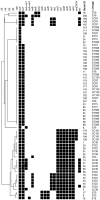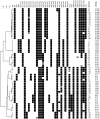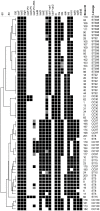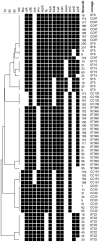Comparative genotypic and phenotypic characterisation of methicillin-resistant Staphylococcus aureus ST398 isolated from animals and humans
- PMID: 22792335
- PMCID: PMC3394705
- DOI: 10.1371/journal.pone.0040458
Comparative genotypic and phenotypic characterisation of methicillin-resistant Staphylococcus aureus ST398 isolated from animals and humans
Abstract
The high prevalence of methicillin-resistant Staphylococcus aureus (MRSA) ST398 among pigs in certain European countries and North America and its occurrence in other animal species raises a question concerning the molecular mechanisms mediating the success of this lineage. In this study a panel of S. aureus strains belonging to sequence type (ST) 5 (n = 4), ST8 (n = 5), ST15 (n = 5), ST22 (n = 8), clonal complex (CC) 30 (n = 8), CC97 (n = 8), CC130 (n = 4), CC151 (n = 4) and ST398 (n = 18) were screened by DNA microarray and PCR for the carriage of virulence and antimicrobial resistance genes. Isolates belonging to the same sequence type/clonal complex (ST/CC) were found to share similar virulence gene profiles. The ST398 lineage displayed the lowest content of virulence genes, which consisted mainly of genes detected among the majority or all of the analysed lineages. All MRSA ST398 isolates lacked accessory virulence genes that were detected in other ST/CC. In contrast to virulence genotype, the antimicrobial resistance genes profiles varied between isolates belonging to the same ST/CC and profile similarities could be observed for isolates from different lineages. MRSA ST398 isolates in particular displayed significant diversity and high content of antimicrobial resistance genes. This was comparable with certain MRSA belonging to other sequence types particularly the equine MRSA ST8. The apparent lack of significant virulence genes among MRSA ST398 strains, demonstrates that the lineage features a unique genetic background but no ST398-specific virulence markers could be identified.
Conflict of interest statement
Figures





Similar articles
-
Microarray based study on virulence-associated genes and resistance determinants of Staphylococcus aureus isolates from cattle.Vet Microbiol. 2007 Nov 15;125(1-2):128-40. doi: 10.1016/j.vetmic.2007.05.016. Epub 2007 May 24. Vet Microbiol. 2007. PMID: 17614219
-
Nationwide molecular epidemiology of methicillin-resistant Staphylococcus aureus responsible for horse infections in France.BMC Microbiol. 2017 May 3;17(1):104. doi: 10.1186/s12866-016-0924-z. BMC Microbiol. 2017. PMID: 28468636 Free PMC article.
-
Characterization of methicillin-resistant Staphylococcus aureus ST398 from cases of bovine mastitis.J Antimicrob Chemother. 2010 Apr;65(4):619-25. doi: 10.1093/jac/dkq021. Epub 2010 Feb 17. J Antimicrob Chemother. 2010. PMID: 20164198
-
Methicillin resistant S. aureus in human and bovine mastitis.J Mammary Gland Biol Neoplasia. 2011 Dec;16(4):373-82. doi: 10.1007/s10911-011-9237-x. Epub 2011 Oct 8. J Mammary Gland Biol Neoplasia. 2011. PMID: 21984431 Review.
-
Staphylococcus aureus and MRSA in Livestock: Antimicrobial Resistance and Genetic Lineages.Microorganisms. 2023 Jan 3;11(1):124. doi: 10.3390/microorganisms11010124. Microorganisms. 2023. PMID: 36677414 Free PMC article. Review.
Cited by
-
Genotypic and phenotypic characterization of Staphylococcus aureus isolates from wild boars.Appl Environ Microbiol. 2013 Mar;79(5):1739-42. doi: 10.1128/AEM.03189-12. Epub 2012 Dec 21. Appl Environ Microbiol. 2013. PMID: 23263963 Free PMC article.
-
Genomic Analysis of Staphylococcus aureus of the Lineage CC130, Including mecC-Carrying MRSA and MSSA Isolates Recovered of Animal, Human, and Environmental Origins.Front Microbiol. 2021 Mar 25;12:655994. doi: 10.3389/fmicb.2021.655994. eCollection 2021. Front Microbiol. 2021. PMID: 33841383 Free PMC article.
-
Evidence for adaptation of porcine Toll-like receptors.Immunogenetics. 2016 Mar;68(3):179-89. doi: 10.1007/s00251-015-0892-8. Epub 2015 Dec 23. Immunogenetics. 2016. PMID: 26701185 Free PMC article.
-
Extensive Genomic Diversity among Bovine-Adapted Staphylococcus aureus: Evidence for a Genomic Rearrangement within CC97.PLoS One. 2015 Aug 28;10(8):e0134592. doi: 10.1371/journal.pone.0134592. eCollection 2015. PLoS One. 2015. PMID: 26317849 Free PMC article.
-
Dose-response relationship between antimicrobial drugs and livestock-associated MRSA in pig farming.Emerg Infect Dis. 2015 Jun;21(6):950-9. doi: 10.3201/eid2106.140706. Emerg Infect Dis. 2015. PMID: 25989456 Free PMC article.
References
Publication types
MeSH terms
Substances
LinkOut - more resources
Full Text Sources
Medical

